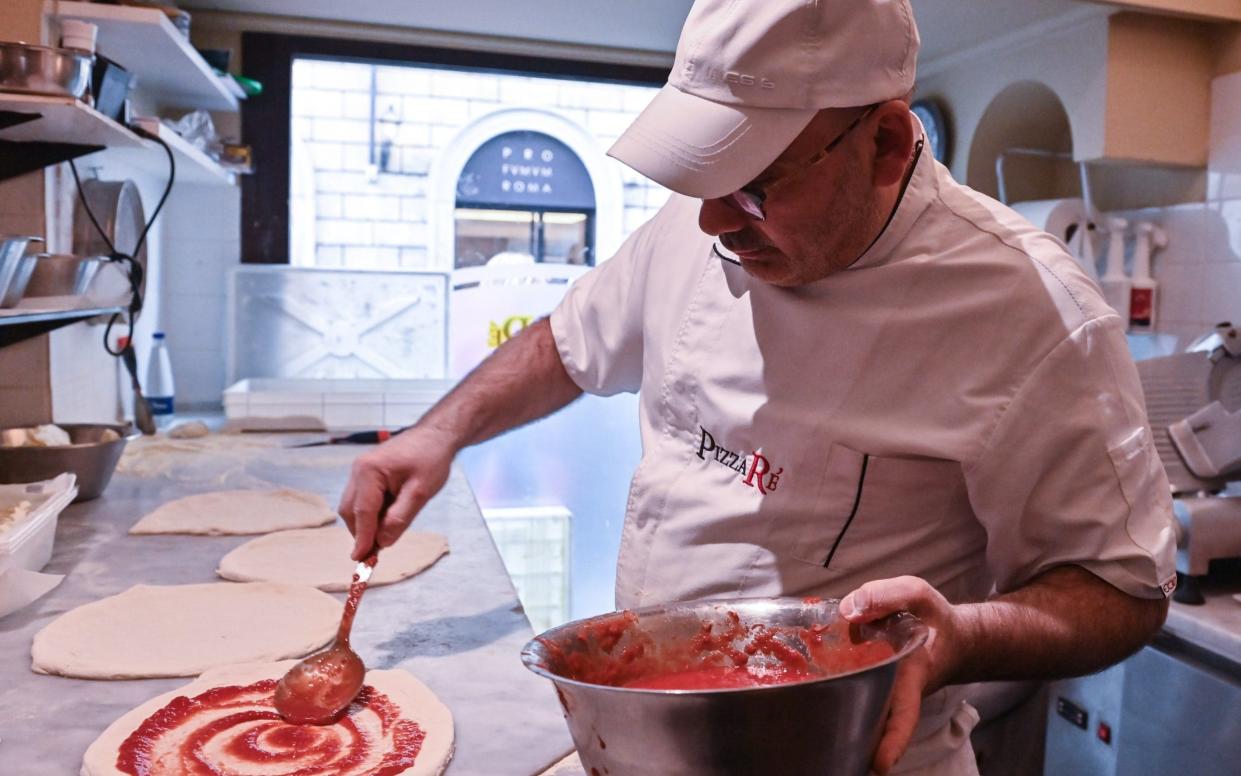Americans not Italians first put tomato sauce on pizza, say food historians

The world has America, not Italy, to thank for the rich red sauce that adorns pizzas, according to a book by a pair of food experts.
Italians only discovered tomato sauce in abundant quantities when they started emigrating to the United States in the 19th century, say Alberto Grandi and Daniele Soffiati in a book called La Cucina Italiana Non Esiste – Italian Cuisine Does Not Exist.
Until then, pizza in Italy was served without tomato sauce and would have consisted of a circular piece of plain focaccia topped with various ingredients, they say.
Not only did tomatoes originate in the New World but so did tomato sauce, the authors claim in their book, which promises to debunk “lies and myths” about Italian cuisine.
“The plant is from America and so is the use of tomato sauce as the basis for our cuisine,” Mr Grandi, a food historian at the University of Parma in northern Italy, told La Repubblica newspaper.
“Italians discovered it overseas, thanks to the industrialisation of food production. Pizza became red in America. Before that it was plain focaccia, sometimes adorned with pieces of tomato.”
The claim that “pizza rossa” or red pizza is an American invention has gone down like a plate of congealed carbonara with Italy’s gastronomic traditionalists, not least in the pizzerias doing a roaring lunchtime trade in Rome.
“That’s rubbish, I don’t believe that’s true,” said Gianni Altrui, as he made a dough base and smothered it in tomato sauce at the Pizza Re trattoria.
“It’s the Americans who learned from the Italians when it comes to food, not the other way around.”

Mr Altrui said pizza with red sauce dated back at least to 1889, when legend has it that the margherita was invented in his home town of Naples.
It was topped with basil, mozzarella and tomato – the green, white and red of the Italian flag – and was supposedly named in honour of the Queen of Italy, Margherita of Savoy.
Mr Altrui, 48, knows a thing or two about pizza – he makes about 300 a day in the restaurant near Piazza del Popolo in the Italian capital. “It’s the only job I’ve ever had. I started when I was 20,” said the veteran pizzaiolo, or pizza maker.
A few hundred yards away, in Piazza Navona, Clariston Alves was also unimpressed with the claim that the Americans invented tomato sauce and therefore pizza as we know it.
“It seems a bit ridiculous to me to say that pizza rossa is not Italian,” he said.
The Brazilian national who has lived in Rome for 30 years pointed at a pizza coming out of the wood-fired oven at the restaurant he manages, Antica Trattoria Agonale.
“Look at this, it’s pizza rossa. The Americans may have adapted it, but I don’t think they invented it.”
But the authors of the new book insist they have solid research to prove their thesis that it was the Americans who started producing tomato sauce on a large scale in the 19th century.
The abundance was seized on by Italian immigrants in the US who opened up restaurants and pizzerias. By the outbreak of the Second World War, there were many more pizzerias in America than there were in Italy, the historians say.
“Pizza was such a success in America and pizzerias so widespread that the majority of Americans were convinced that pizza was a 100 per cent Yankee dish,” the authors say in their book.
“That conviction was reinforced during the war. When American soldiers landed in Sicily, they discovered to their surprise that pizzerias barely existed in Italy.”
It is not the first time that Mr Grandi, who teaches food history, has challenged the mythology surrounding Italy’s culinary traditions.
He says one of Italy’s most beloved dishes, spaghetti alla carbonara, was invented during the Second World War using the bacon, cheese and powdered eggs that American troops brought over.
He claims that Italians subscribe to a sort of “gastro-nationalism” in which they will not tolerate any questioning of the country’s classic dishes. He accuses Italians of clinging to “fairy tales” about their cuisine as a way of reinforcing national pride and identity.
“Questioning any of the myths of Italian cuisine is to place into question roots that go back centuries, it is seen as an affront. Even though we never call into doubt the quality of these dishes,” said Mr Grandi.
Authentic Italian cuisine ‘does not exist’
The authors claim that Italy was an impoverished country during the 19th century and that many people suffered from malnutrition.
“Italians were subsisting on polenta and practically dying of hunger,” said Mr Soffiati.
He claims it was only when they emigrated to countries like the US that they were able to afford meat and to start enjoying a better diet.
It was there that they discovered tomato sauce, which was being produced in industrial quantities in America thanks to innovations in production and canning.
Authentic Italian cuisine does not exist, “at least in the way it is intended by the gastro-nationalists”, said Mr Soffiati.
Italians’ fixation with their cuisine is a way of affirming their identity in a rapidly changing world of globalisation and immigration, the authors believe.
The conservative coalition led by prime minister Giorgia Meloni has jumped on the bandwagon, appointing a minister for food sovereignty and railing against the threats posed by laboratory-grown meat and food products made from insects like crickets.
“We are a country that is going through an identity crisis and food is one of the few things to be proud of,” said Mr Grandi.
“It chimes with the rhetoric of certain politicians – that we are being besieged by the world and they want us to abandon our extraordinary food heritage and instead eat insects and cultivated meat.”


